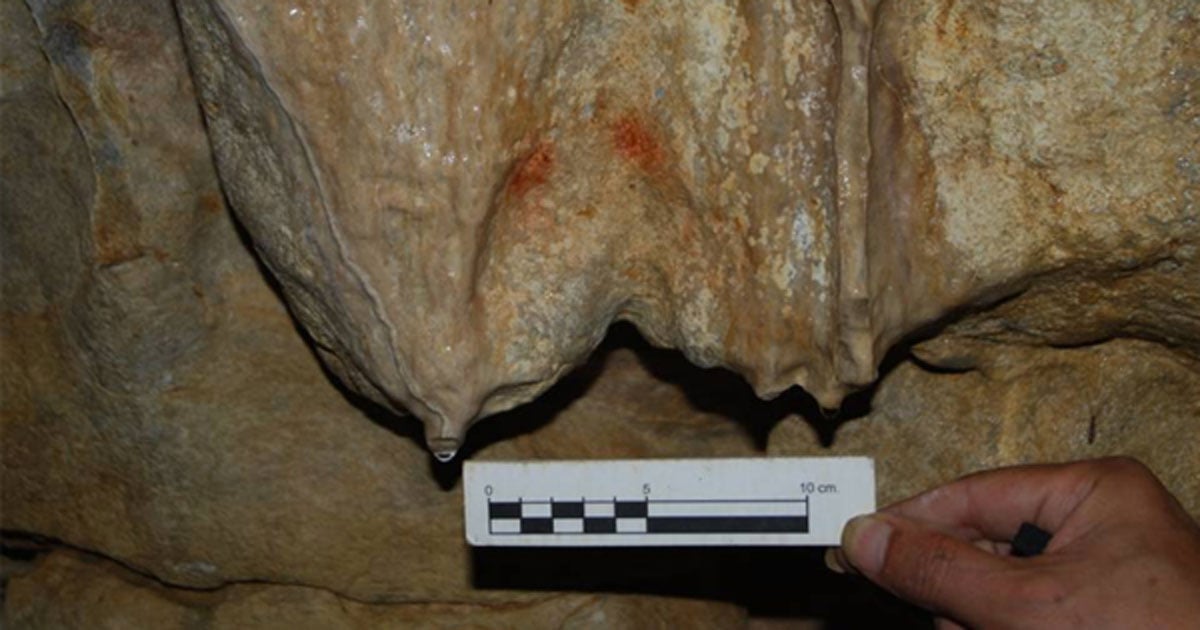New Technology Finds Barely Visible 28,000-year- old Cave Paintings in Spain
Just because we cannot see it, does not mean it cannot exist. Non-intrusive technology using photometric techniques has aided a team of researchers in uncovering four new sets of designs painted on the walls of Spanish caves thousands of years ago. The oldest of the paintings is nearly 30,000 years old –one of the oldest examples of prehistoric art found to date. The discoveries open a world of possibilities in identifying and analyzing paleolithic cave art.
IBTimes UK reports that researchers in Cantabria, Spain were tipped off to the possible existence of the cave art by a speleologist 20 years ago. However, it is only recently that sufficiently advanced technology has become available to confirm those claims.

Some of the paintings recently identified on the walls of one of the caves in Cantabria, Spain. (Roberto Ontañón/MUPAC)
Cantabria is the home to one of the highest known concentrations of prehistoric cave paintings in the world. Project leader, Spanish prehistorian Roberto Ontañón explained to El País: “It was a very good place to live during the Ice Age. The Cantabrian Sea warmed up the climate and vast herds of wild animals such as horses passed through that narrow strip between the sea and the mountains.”
- Kizil Caves, earliest Buddhist caves in China, hide rare images from the time of the Silk Route
- The Louvre of the Desert: The Impressive Rock Paintings of Tsodilo, Botswana
According to El País, the researchers have used a range of photographic techniques, lasers, and 3D scanners while searching four caves – El Rejo, Las Graciosas, Los Murciélagos, and Solviejo. They captured a series of images under different lighting and angles and have identified several geometric designs and a few drawings of deer. The team reproduced the prehistoric paintings as high-definition images on a computer. Measurements of brush and tool marks were also attained in the process.

An image of a deer created through photometric techniques from the El Rejo cave in Cantabria. (Museo de Prehistoria y Arqueología de Cantabria)
Ontañón told IBTimes UK: “These technologies allow you to detect colors beyond the range of the visible spectrum (infrared to ultraviolet) and, in this way, 'reveal' paintings that at first sight are imperceptible or difficult to distinguish.”
The researchers estimate the paintings were created between 22,000 and 28,000 years ago, thus they are older than the famous paintings of Altamira, which are dated to the Magdalenian occupation (circa 16500 – 14000 years ago). The artists who made the Altamira paintings used ochre, hematite, and charcoal to draw bison, horses, boar, and an impressive doe.

Bison from Magdalenian occupation of Altamira Cave. In black charcoal, c. 16500 – 14000 years ago. (CC BY SA 3.0)
The oldest known cave drawings in the world are also found in Cantabria at a site known as El Castillo. Those paintings include more than 100 images on walls and ceilings made in charcoal and red ochre. There are representations of animals, club-shaped figures, and numerous hand stencils and red disks. It is estimated that those images were made more than 40,000 years ago.
That date is controversial, suggesting that modern humans were in the area earlier than mainstream research suggests, or that the paintings were made by Neanderthals. Although it is certainly possible, if Neanderthals created the cave paintings at El Castillo, that also goes against the general belief that Neanderthals didn’t create symbolic art, or raises the question as to why they seemed to have “suddenly” begun the practice around 40,000 years ago.
- Stone age Rock Art in Famous Cave of Forgotten Dreams May Show Oldest Human Depiction of Volcanic Eruption
- Creating Prehistoric Culture: Were the First Artists Women?

Cro-Magnon artists painting woolly mammoths in Font-de-Gaume, AMNH. (Public Domain)
More discoveries in the area may help shed light on the origins of the oldest cave paintings. According to Ontañón, there are at least 70 caves in the Cantabrian mountain range with paintings. Ontañón told El País his team plans to continue searching for them:
“Our goal is to visit the caves and use the latest technology to uncover walls that have been painted or decorated but where these marks cannot be seen with the naked eye. These discoveries will add to the map of art in this area.”
The project is being funded by the regional government of Cantabria.

General view of cave walls in Cantabria, Spain. (El Comercio)
Top Image: Part of an area being scanned by scientists at Los Murciélagos, a cave in Cantabria, Spain. Source: Museo de Prehistoria y Arqueología de Cantabria


















Comments
That graphic depicts men creating these drawings. More likely, men were focused on the hunt. The artists were probably the women and children, and perhaps there were art classes like we have today. Why not?